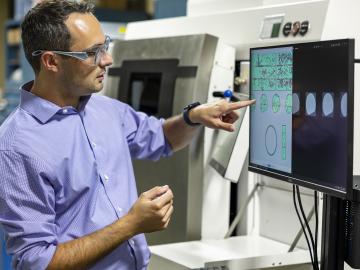
Filter News
Area of Research
News Type
Date
News Topics
- 3-D Printing/Advanced Manufacturing (9)
- Advanced Reactors (2)
- Artificial Intelligence (11)
- Big Data (3)
- Bioenergy (5)
- Biology (7)
- Biomedical (2)
- Biotechnology (3)
- Buildings (3)
- Chemical Sciences (8)
- Climate Change (12)
- Composites (2)
- Computer Science (8)
- Coronavirus (2)
- Critical Materials (1)
- Cybersecurity (3)
- Decarbonization (8)
- Education (3)
- Energy Storage (7)
- Environment (8)
- Exascale Computing (3)
- Frontier (4)
- Fusion (2)
- Grid (3)
- High-Performance Computing (13)
- Isotopes (2)
- Machine Learning (4)
- Materials (28)
- Materials Science (7)
- Microscopy (4)
- Molten Salt (1)
- Nanotechnology (2)
- National Security (4)
- Net Zero (2)
- Neutron Science (8)
- Nuclear Energy (5)
- Partnerships (18)
- Physics (4)
- Polymers (1)
- Quantum Computing (3)
- Quantum Science (4)
- Renewable Energy (1)
- Security (2)
- Simulation (7)
- Summit (2)
- Sustainable Energy (2)
- Transportation (5)
Media Contacts

Scientists at ORNL used their expertise in quantum biology, artificial intelligence and bioengineering to improve how CRISPR Cas9 genome editing tools work on organisms like microbes that can be modified to produce renewable fuels and chemicals.

Researchers at the Department of Energy’s Oak Ridge National Laboratory have improved flaw detection to increase confidence in metal parts that are 3D-printed using laser powder bed fusion.

The application to participate in the third cohort of the Techstars Industries of the Future Accelerator in Knoxville, Tennessee, is open through Nov. 29, 2023.

As vehicles gain technological capabilities, car manufacturers are using an increasing number of computers and sensors to improve situational awareness and enhance the driving experience.

In a finding that helps elucidate how molten salts in advanced nuclear reactors might behave, scientists have shown how electrons interacting with the ions of the molten salt can form three states with different properties. Understanding these states can help predict the impact of radiation on the performance of salt-fueled reactors.

Using neutrons to see the additive manufacturing process at the atomic level, scientists have shown that they can measure strain in a material as it evolves and track how atoms move in response to stress.

The Department of Energy’s Oak Ridge National Laboratory and Tennessee State University have signed a memorandum of understanding to strengthen research cooperation and provide diverse undergraduate students enriching educational research opportunities at the lab.

ORNL and the University of Texas Rio Grande Valley, known as UTRGV, have signed a memorandum of understanding to strengthen research cooperation and establish a collaborative program for undergraduate research and education, further cementing hi

Susan Hubbard, diputada de Ciencia y Tecnología en ORNL, Can (John) Saygin, vicepresidente mayor de investigación y decano del Colegio de la Escuela de Postgrados en UTGRV, firman un Memorándum de Entendimiento comprometiéndose a fortalecer

As current courses through a battery, its materials erode over time. Mechanical influences such as stress and strain affect this trajectory, although their impacts on battery efficacy and longevity are not fully understood.


